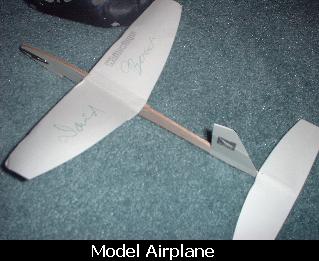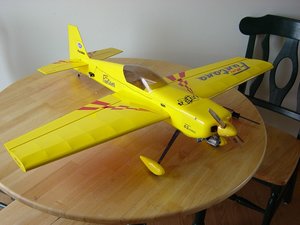Model aircraft
|
|
Aircraft modeling or aeromodelling is a hobby that has been popular since the 1930s. It is constructing small airplanes using materials such as balsa wood, foam, fiberglass, etc. A vast array of designs are possible, from ultra-simple gliders such as that pictured, to highly accurate scale models, some of which can be very large - maybe 1/3rd scale or more.
Models may be built either as static non-flying models, or as flying models (also known as aeromodelling). Construction techniques for the two are usually very different.
| Contents |
Static model aircraft
Static model aircraft, those not intended to fly, are commonly built using plastic detail parts, photo etched brass, and wire, though other materials such as wood, metal, and paper are also often used. Some static models are scaled for use in wind tunnels, where the data acquired is used to aid the design of full scale aircraft.
Models can be bought already built and painted, as well as models that require construction, painting and gluing, or snap fit models (most of which come with decals or paint already applied).
The collector can choose from plastic and diecast military and commercial helicopters and planes; and for the less skilled collector, snap together military and commercial planes. Snap models are becoming increasingly popular because of their ease of construction.
Plastic model plane manufacturers include Revell who are generally recognized as the most popular manufacturer of plane models in the US, Airfix, whose name is synonymous with the hobby in the UK, Hobbycraft, DML, Frog, Matchbox, Minicraft and Hasegawa, Tamiya and Testors. The peak of the plastic modelling hobby was most probably the 1970s, and while it is still very popular today, at that time the hobby could support a considerable number of competing, large companies. During the 1980s, many of them were forced to radically downsize, restructure, merge, or go out of business. Some attribute this to the rise of computer games over the more traditional type of hobbies. Another consideration is that kits have generally required considerable skill and patience to achieve good results, and that ready-made or more quickly constructed models have taken over the market for those simply looking for a toy to play with.
Plastic scale model aircraft kits usually come in standard scales such as 1/144, 1/72, 1/48 (also known as quarter-scale), and 1/32. This scale indicates the relationship between the size of the model and the size of the actual aircraft. For example, in 1/48 scale, 1 mm on the model represents 48 mm on the actual aircraft. One of the most expensive airplane models in the world, that of a Boeing 707 made in the 1/10 scale, is valued at $18,000 dollars.
Die-Cast model plane manufacturers include Dyna-Flytes (recognized as the first manufacturer of that type of model), Schabak, Gemini Jets and Herpa Wings.
Snap Fit plastic plane models include Wooster, Long Prosper(In South Africa, Long & Prosper), and Flight Miniatures of Cottonwood, Arizona.
Vacuum formed kits are generally for the more skilled collector and are manufactured by small companies such as Koster Aero Enterprises. Specialized kits cast in resin are also available.
Another category are scale plane models made from heavy paper or card stock. Several card model kit companies exist, smaller even than Vacuum formed manufacturers, among them being ModelArt, Halinski, Modelik, JSC and FlyModel. Many card models are also distributed through the internet, and several are offered this way free of charge. Card model kits are also not limited to just airplanes. Such kits are available for all types of vehicles, buildings, computers, firearms, even animals.
Most of the world's airlines allow their fleet aircraft to be modelled as a form of publicity, some of the most notable being Delta Airlines, Air France, British Airways, Aerolíneas Argentinas, Avianca, Aeroméxico, Fed Ex, Polar Air Cargo, Air New Zealand, Qantas, China Airlines, South African Airways, Finnair, and Royal Jordanian.
Flying model aircraft
Microflyer1.jpg
Flying models are usually what is meant by the term aeromodelling. Aeromodelling can be divided into: competition flying, and fun flying.
Construction
Flying models have to be designed according to the same principles as full-sized aircraft, and therefore their construction is very different from most static models. In fact, construction techniques similar to full-sized aircraft (especially older ones) are often used. These might consist of forming the structure of the model using thin strips of light wood such as balsa, then covering it with fabric and doping it to make it shrink on the frame and become airtight. Lightness is essential, but so is having sufficient strength to accommodate the forces of flight.
An alternative to fabric and dope is very thin paper and dope for very light models, or modern plastic films ("solarfilm") that can be ironed on - heat from the iron both glues it to the frame and causes the material to tighten.
Traditional construction techniques consist of using formers and longerons for the fuselage, and spars and ribs for the wings and tail surfaces. More robust designs often use solid sheets of wood to form these instead, or might employ a composite wing consisting of an expanded polystyrene core covered in a protective veneer of wood, often obechi. Such designs tend to be heavier than an equivalent sized model built using the traditional method, and would be much more likely to be found in a power model than a glider.
Powered models
Power models may use a variety of engines. Most typically, models use simple single-cylinder internal combustion engines using a glow plug ignition system, a two-stroke cycle and a volatile fuel such as methanol boosted with nitromethane. Castor oil or other synthetic oil is often added as a lubricant. However, there are many variations on this, including multi-cylinder engines, four-strokes, etc. Some simple models have been powered by compressed gas (CO2) engines. Alternatives include electric motor power which until the early 1990's was not really feasible due to the weight of batteries and lack of development, but has become popular more recently as it is far cleaner, simpler, more reliable, more efficient and much quieter than a fueled engine. Advanced features include highly-efficient brushless motor systems, better electronic speed controls (ESC's) and ultra-lightweight lithium polymer batteries. Electric models powered by nickel cadmium or nickel metal hydride rechargeable batteries were more common up until 2005, but since then lithium polymer batteries have gradually become very popular due to their lower weight, multiple flight capability and very low self-discharge rates.
A traditional method of powering free flight models is using an elastic motor, essentially a long rubber band that is wound up prior to flight. The benefits are extreme simplicity, but drawbacks of this approach include limited running time, the need for a very strong fuselage to accommodate the strain, and an exponential reduction of thrust over time. All of these methods provide thrust by the use of a propellor, or possibly an internal ducted fan.
A recent development is the use of small jet turbine engines powered by a mix of A1 jet fuel and synthetic motorcycle engine oil. Their size and thrust make them suitable only in giant-scale model aircraft. Jet-powered R/C is still very much a new and pricey area pursued only by a hard core of enthusiasts. Another alternative, infrequently used, is the use of small solid fuel rocket engines - a type of model rocket motor called the Jetex engine was quite popular in the 1950s.
Gliders
Model gliders are usually either hand launched or launched using an elastic bungee catapult. Often gliders are flown at sites where natural conditions provide continuous lift, such as the side of a hill where the wind is blowing upward. This is called slope soaring, and gliders are able to stay in the air almost indefinitely when flown skillfully in the right conditions. Also, sailplanes are flown using available thermal lift. This is challenging because thermals cannot be seen except by the reaction of the sailplane to the unseen rising air currents. Unpowered thermal flights can often last an hour or more.
Most flying model aircraft can be placed in one of three main groups:
- Free flight (F/F) model aircraft are designed and built in a manner that allows the craft to fly without any attachment to the ground.
This type of model pre-dates the efforts of the Wright Brothers. [1] (http://www.geocities.com/aerohydro/mfm/model.htm) - Control line (C/L) model aircraft are designed and built to be flown using cables (usually two) leading from the wing to the pilot. A variation of this system is the Round-the-pole flying (RTP) model.
- Radio control (R/C) model aircraft have a transmitter operated by the pilot on the ground, sending signals to a receiver in the craft.
Anyone wishing to take up R/C model aircraft is strongly advised to join a club. The experienced hobbyists in a club generally extend a warm welcome to beginners, and take great efforts to help them learn about the models and the equipment, and how best to install it and set it up. They help newcomers avoid disappointment and painful and expensive mistakes.They generally offer first rate flying tuition at no expense. Most clubs belong to a national body representing the hobby principally so members are covered by insurance and so that safe flying conditions can be maintained. The governing body for model aeroplane enthusiasts in the USA is the AMA (http://www.modelaircraft.org/) and in Canada it is MAAC (http://www.maac.ca/). In the last 10 years Almost-Ready-To-Fly (ARF) radio control aircraft have allowed new people to enter the hobby without the need to first build an aircraft from kit form. Even more recently Ready-To-Fly (RTF) radio control aircraft have further assisted new members of the hobby to start enjoying the flying aspects without having to put in any preliminary work. These types of models have become controversial as some consider that they remove the dedication and hard work associated with model aircraft and generally reduce the capabilities and adaptability of the model. Brands associated with these types of aircraft include Great Planes, Hobbico, E-Flite, Hangar 9, GWS, HobbyZone and ParkZone.
See also
External links
- Aeromodelling, how aircraft fly and how to control them etc (http://www.aeromodelling.de.vu)
- Amateur onboard video (Windows Media format) showing an entire flight from take-off to landing (http://link4.streamhoster.com/?u=2thDr&p=%2FFlying+on+the+Farm.wmv&odaid=952&prog=true)
- The FAI, the world air sports federation which controls model aeroplane competition categories and rules amongst other things (http://www.fai.org)
- Tournament Of Champions (http://www.desertaircraft.com/article.php?Page=2000TOCPhotos)
- Electric Flight, electrically powered model aeroplanes for newcomers (http://www3.sympatico.ca/rwoolley/)
- Model Aeronautics Association of Canada (MAAC) (http://www.maac.ca/)
- Glossary (http://members.aol.com/bentleyflyers/glossary.html)
- High altitude glider (http://members.shaw.ca/sonde/index.htm)
- Academy of Model Aeronautics (AMA) (http://www.modelaircraft.org/)
- Radio controlled helicopters (http://www.myhelicopters.com/)
- How to build a model airplane (http://www.2020site.org/modelplane/index.html)
Template:Scale modelda:Modelfly de:Flugmodell es:Aeromodelismo eo:Aviadmodelismo fr:Modélisme aérien he:טיסנאות ia:Aeromodellismo nl:Modelvliegtuig pt:Aeromodelismo


